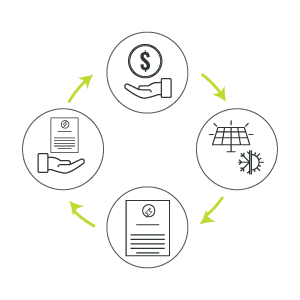What is the Victorian Energy Upgrades (VEU) Program?
The Victorian Energy Upgrades (VEU) program helps Victorians reduce their energy bills and greenhouse gas emissions by providing access to discounted energy efficient products and services.
Discounts are represented through Victorian Energy Efficiency Certificates (VEECs) and are created through the process of upgrading old, inefficient products, to new energy-efficient technologies. Each VEEC is assigned a monetary value that changes depending on supply and demand in the market.
How is Ecovantage involved in the program?
To create VEECs for energy efficient upgrades and installations, you need to hold an accreditation issued by the VEU. Companies who hold this accreditation are known as Accredited Persons (APs).
Ecovantage was founded in 2007 and is now one of the oldest, largest and most versatile APs in Australia, with a long history helping installation companies create certificates such as VEECs.

What type of heating/cooling technologies can be upgraded under this program?
To be eligible for creating VEECs under this program, houses with existing gas/electric heaters must be connected to a gas/electric supply before it is decommissioned. Evidence of this will be required.
Decommissioned technologies include:
- Hard-wired resistance electric room heater (which is the main form of heating any premises)
- Central electric resistance or slab heater (which is the main form of heating any premises)
- Ducted reverse cycle (which is the main form of heating any premises)
- Non-ducted reverse cycle
- Ducted gas heater (which is the main form of heating any premises)
- Non-ducted gas heater
What are the decommissioning requirements?
Sometimes the old product won’t be able to be physically removed from site because it’s:
- impractical
- unsafe or
- it would require a lot of additional, costly repair work
In these cases, each decommissioned product can be left at site but must be decommissioned in a practical and safe manner to ensure it cannot be reused again.
Examples of decommissioning can include capping the gas connection, cutting the wires and either
- removing control gear/heating element or
- disabling control gear/heating element.
What are the recycling requirements?
Every removed technology must be recycled at an authorised recycling facility.
These facilities will provide a recycling certificate to confirm what heaters have been recycled and how many. This is required for compliance.
What training & licensing is required for heating/cooling upgrades?
As with all electrical, plumbing or refrigerant installations in Australia, those carrying out any work must carry the correct licence in order to do the work legally. The same applies for upgrades under the VEU program.
Plumbing Licensing – Victorian Building Authority (VBA)
Removing:
- Licenced in gas-fitting: If removing a gas heater
- Licenced in refrigerated air-conditioning work or the appropriate class of mechanical services work: if removing a reverse cycle unit.
Installing:
- Licenced in refrigerated air-conditioning work or the appropriate class of mechanical services work: if installing a reverse cycle unit.
* Registered plumbers must be supervised by a licenced plumber when undertaking the plumbing work.
Electrical Licencing – Energy Safe Victoria (ESV)
- A-grade licence
Refrigerant Handling Licencing – Australian Refrigeration Council (ARC)
- RSS03: single-splits and ducted units
- RAC01: multi-head splits
What documents & photos are required for compliance?
Every job has to be signed off for compliance by Ecovantage before it is eligible for VEECs. A series of documents and photos are required as part of the compliance and these are generated by the installer before, during and after the install.
An example of the required documents and photos for the replacement of an old gas heater with a new reverse cycle air conditioner would include the following:
Documents
- VBA Compliance Certificate
- Certificate of Electrical Safety (CoES)
- Customer Tax Invoice
- Recycling Certificate
Photos
Old heater
- ‘In situ’; i.e. before you disconnect any power/gas
- Compliance plate
- Method of decommissioning; i.e. after you disconnect from power/gas
New reverse cycle indoor unit(s)
- ‘In situ’; i.e. after you’ve fully installed
- Compliance plate
New reverse cycle outdoor unit
- ‘In situ’; i.e. after you’ve fully installed
- Compliance plate
How can my business start generating VEECs?
If your business is installing heating, cooling, hot water or solar in Victoria, get in touch with our team to see if your products are eligible for creating VEECs and how much they are worth to you and your customers.

Ben Lumley | Programs & Account Manager VIC
Ben specialises in VEU Activities (Residential Retrofits, Residential & Commercial Heat Pumps, Air Conditioning, Commercial Lighting), and ESS Activities (IHEAB Heat Pumps).
 Victoria
Victoria New South Wales
New South Wales South Australia
South Australia Queensland
Queensland

